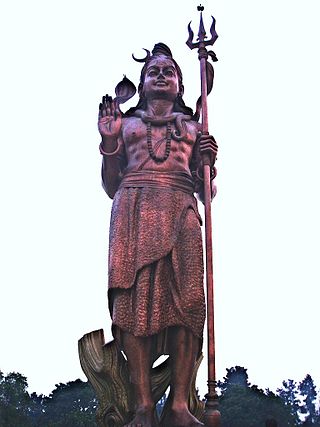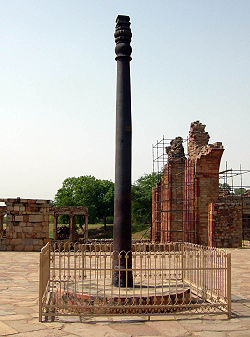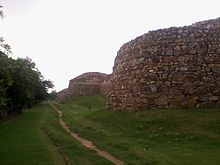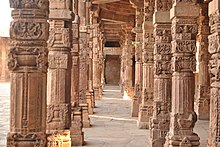
Mehrauli is a neighbourhood in South Delhi, Delhi, India. It represents a constituency in the legislative assembly of Delhi. The area is close to Gurugram and next to Vasant Kunj.

Hansi, is a city and municipal council in Hisar district in the Indian state of Haryana. It appears that at one time Hansi was larger, more prosperous and more important than Hisar. The town has several important buildings of archeological importance.
Tughluqabad Fort is a ruined fort in Delhi, India. It was constructed by Ghiyasuddin Tughluq, the founder of the Tughlaq dynasty, of the Delhi Sultanate in 1321 as he established the third historic city of Delhi, but it was later abandoned in 1327. It lends its name to the nearby Tughluqabad residential-commercial area as well as the Tughluqabad Institutional Area. Ghiyasuddin Tughluq also built the Qutub-Badarpur Road, which connected the new city to the Grand Trunk Road. The road is now known as Mehrauli-Badarpur Road. The entry fee for the Fort is Rs. 20 for Indians. Also, nearby is Dr. Karni Singh Shooting Range and Okhla Industrial Area.

Lal Kot or Qila Rai Pithora is a fortified complex in present-day Delhi, which includes the Qutb Minar complex. It was constructed in the reign of Tomar Rajput king Anangpal Tomar between c. 1052 - c.1060 CE. It is termed as the "First city of Delhi". Remains of the fort walls are scattered across South Delhi, visible in present Saket, Mehrauli around Qutb complex, Sanjay Van, Kishangarh and Vasant Kunj areas.

Taragarh Fort is a fortress built upon a steep hillside in the city of Ajmer in the Indian state of Rajasthan. It was constructed in the 8th century by Ajayaraja Chauhan (721–734) and it was originally called Ajaymeru Durg.

The Gwalior Fort, commonly known as the Gwāliiyar Qila, is a hill fort near Gwalior, Madhya Pradesh, India. The fort has existed at least since the 10th century, and the inscriptions and monuments found within what is now the fort campus indicate that it may have existed as early as the beginning of the 6th century. The modern-day fort, embodying a defensive structure and two palaces was built by the Tomar Rajput ruler Man Singh Tomar. The fort has been administered by a number of different rulers in its history.

Delhi has been an important political centre of India as the capital of several empires. The recorded history of Delhi begins with the 8th century Tomar Rajputs kingdom. It is considered to be a city built, destroyed and rebuilt several times, as outsiders who successfully invaded the Indian subcontinent would ransack the existing capital city in Delhi, and those who came to conquer and stay would be so impressed by the city's strategic location as to make it their capital and rebuild it in their own way.

Hinduism is the majority religion in Delhi, India. According to the 2011 Census of India, the National Capital Territory of Delhi has 13,712,100 Hindus, who form 81.68% of the population. Hinduism can be extensively seen in culture and history of Delhi and was established by Hindu Tomara king, Anangpala. Though, the Hindus have seen some decline in the Delhi Sultanate and Mughal Empire, due to conversions and persecution. Delhi is also home to many Hindu temple and ashrams. There are more than 590 registered temples in Delhi, out of which Kalka, Birla, Akshardham and ISKCON Temple are the most visited.

Surajkund is an ancient reservoir of the 10th century located on Southern Delhi Ridge of Aravalli range in Faridabad city of Haryana state about 8 km from South Delhi. Surajkund is an artificial Kund built in the backdrop of the Aravalli hills with an amphitheatre shaped embankment constructed in semicircular form. It is said to have been built by the king Surajpal of the Tomara Rajputs in the 10th century. Tomar, a younger son of Anangpal Tomar – the Rajput ruler of Delhi, was a sun worshipper and he had therefore built a Sun temple on its western bank. Surajkund is known for its annual fair "Surajkund International Craft Mela", 2015 edition of this fair was visited by 1.2 million visitors including 160,000 foreigners with more than 20 countries participating in it.

Yogmaya Temple, also Jogmaya temple, is a Hindu temple dedicated to the goddess Yogmaya, also considered to be a sister of Krishna as she took avatar as Vindhyavasini, and situated in Mehrauli, New Delhi, India, close to the Qutb complex. According to local priests and native records, this is one of those 27 temples destroyed by Mamluks and it is the only surviving temple belonging to pre-sultanate period which is still in use. Hindu king Samrat Vikramaditya Hemu reconstructed the temple and brought back the temple from ruins. During Aurangzeb's reign a rectangular Islamic Style hall was added to the temple. Though its original architecture could never be restored after its destruction by Islamic rulers, but its reconstruction had been carried out repetitively by the locals.

Agrawals are the descendants of Maharaja Agrasen who was a legendary Indian king of Agroha, a city of traders. He is the descendant of Kush, son of lord Ram and he was born in 35th generation after lord Ram. He is credited with the establishment of a kingdom of traders in North India named Agroha, and is known for his compassion in refusing to slaughter animals in yajnas. Agrawal Jains are an Indian Jain community who originated from Agroha near Hisar, Haryana. In Sanskrit inscriptions and texts, the community is termed Agrotakanvaya.
Ramshah Tomar was the last Tomara Rajput king of Gwalior. Owing to his valour, Udai Singh married one of his daughter to Ramshah's son Shalivahan Singh Tomar.
The Rawe Rajput is a subcaste of Rajputs found in the Indian states of Delhi and Uttar Pradesh. They are descendant of eminent rulers of aristocratic Rajput clans. The variations of the name include Raya/Raye/Rava/Rave/Rawa/Rawe Rajput

The Anangpur Dam is an Indian hydraulic engineering structure built during the reign of the King Anangpal I of the Tomara Rajputs in the 8th century. It is located near the Anangpur village in Faridabad district, Haryana, India.

The Tomara dynasty ruled parts of present-day Delhi and Haryana in India during 8th-12th century. Their rule over this region is attested to by multiple inscriptions and coins. In addition, much of the information about them comes from medieval bardic legends. They belonged to the Tomar clan of the Rajputs.

The Feroz Shah Kotla or Kotla was a fortress built circa 1354 by Feroz Shah Tughlaq to house his version of Delhi city called Firozabad.

Asigarh Fort, also called Hansi Fort, is located on the eastern bank of Amti lake in Hansi city of Haryana, India, about 135 km from Delhi on NH9. Spread over 30 acres, in its prime days this fort used to be in control of 80 forts in the area around it. The fort is said to be one of the most impregnable forts of ancient India and has been declared a centrally protected monument by ASI in 1937.

Mehrauli Archaeological Park is an archaeological area spread over 200 acre in the Mehrauli neighbourhood of the South Delhi district of Delhi, India, adjacent to the Qutub Minar and the Qutb complex. It consists of over 100 historically significant monuments. It is the only area in Delhi known for 1,000 years of continuous occupation, and includes the ruins of Lal Kot built by Tomar Rajputs in 1060 CE, making it the oldest extant fort of Delhi, and architectural relics of subsequent period, rule of Khalji dynasty, Tughlaq dynasty, Lodhi dynasty of Delhi Sultanate, Mughal Empire, and the British Raj.

The Baolis of Mehrauli are four stepwells approached through single stage or three stage steps, located in Mehrauli in Delhi, India, in the Mehrauli Archaeological Park mainlined by the Archaeological Survey of India. These are the Anangtal Baoli, the Gandhak Ki Baoli, and the Rajon Ki Baoli. These were built below the ground level as ground water edifices and were built near shrines in medieval times.

Anangpur is a historical village located near Faridabad in Haryana, India. Anangpur forms a geographical triangle along with Mehrauli and Tugluqabad. It was the earliest settlement of the Tomara dynasty. Anangpur was the capital of the Tomar king, Anangpal Tomar I, who had built the fort and monuments here.





















